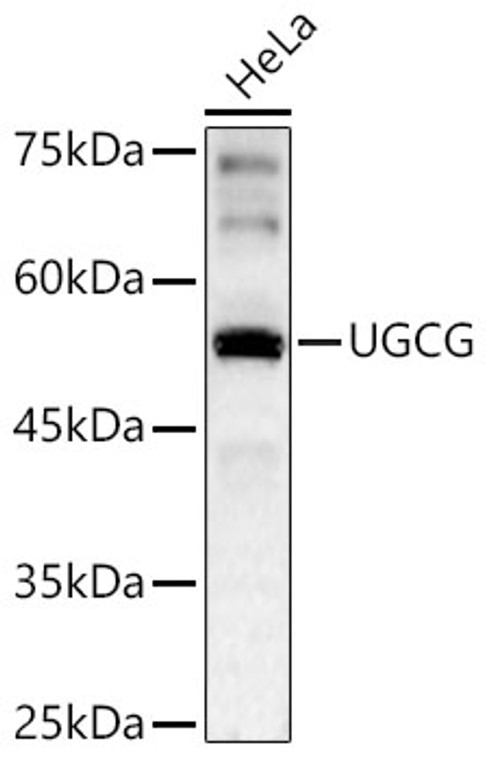| Host: |
Rabbit |
| Applications: |
WB |
| Reactivity: |
Human/Mouse/Rat |
| Note: |
STRICTLY FOR FURTHER SCIENTIFIC RESEARCH USE ONLY (RUO). MUST NOT TO BE USED IN DIAGNOSTIC OR THERAPEUTIC APPLICATIONS. |
| Short Description: |
Rabbit polyclonal antibody anti-UGCG (33-195) is suitable for use in Western Blot research applications. |
| Clonality: |
Polyclonal |
| Conjugation: |
Unconjugated |
| Isotype: |
IgG |
| Formulation: |
PBS with 0.02% Sodium Azide, 50% Glycerol, pH7.3. |
| Purification: |
Affinity purification |
| Dilution Range: |
WB 1:500-1:2000 |
| Storage Instruction: |
Store at-20°C for up to 1 year from the date of receipt, and avoid repeat freeze-thaw cycles. |
| Gene Symbol: |
UGCG |
| Gene ID: |
7357 |
| Uniprot ID: |
CEGT_HUMAN |
| Immunogen Region: |
33-195 |
| Immunogen: |
Recombinant fusion protein containing a sequence corresponding to amino acids 33-195 of human UGCG (NP_003349.1). |
| Immunogen Sequence: |
TRLHLNKKATDKQPYSKLPG VSLLKPLKGVDPNLINNLET FFELDYPKYEVLLCVQDHDD PAIDVCKKLLGKYPNVDARL FIGGKKVGINPKINNLMPGY EVAKYDLIWICDSGIRVIPD TLTDMVNQMTEKVGLVHGLP YVADRQGFAATLEQVYFGTS HPR |
| Tissue Specificity | Found in all tissues examined. |
| Function | Participates in the initial step of the glucosylceramide-based glycosphingolipid/GSL synthetic pathway at the cytosolic surface of the Golgi. Catalyzes the transfer of glucose from UDP-glucose to ceramide to produce glucosylceramide/GlcCer (such as beta-D-glucosyl-(1<->1')-N-acylsphing-4-enine). GlcCer is the core component of glycosphingolipids/GSLs, amphipathic molecules consisting of a ceramide lipid moiety embedded in the outer leaflet of the membrane, linked to one of hundreds of different externally oriented oligosaccharide structures. Glycosphingolipids are essential components of membrane microdomains that mediate membrane trafficking and signal transduction, implicated in many fundamental cellular processes, including growth, differentiation, migration, morphogenesis, cell-to-cell and cell-to-matrix interactions. They are required for instance in the proper development and functioning of the nervous system. As an example of their role in signal transduction, they regulate the leptin receptor/LEPR in the leptin-mediated signaling pathway. They also play an important role in the establishment of the skin barrier regulating keratinocyte differentiation and the proper assembly of the cornified envelope. The biosynthesis of GSLs is also required for the proper intestinal endocytic uptake of nutritional lipids. Catalyzes the synthesis of xylosylceramide/XylCer (such as beta-D-xylosyl-(1<->1')-N-acylsphing-4-enine) using UDP-Xyl as xylose donor. |
| Protein Name | Ceramide GlucosyltransferaseGlct-1Glucosylceramide SynthaseGcsGlycosylceramide SynthaseUdp-Glucose Ceramide GlucosyltransferaseUdp-Glucose -N-Acylsphingosine D-Glucosyltransferase |
| Database Links | Reactome: R-HSA-1660662 |
| Cellular Localisation | Golgi Apparatus MembraneMulti-Pass Membrane Protein |
| Alternative Antibody Names | Anti-Ceramide Glucosyltransferase antibodyAnti-Glct-1 antibodyAnti-Glucosylceramide Synthase antibodyAnti-Gcs antibodyAnti-Glycosylceramide Synthase antibodyAnti-Udp-Glucose Ceramide Glucosyltransferase antibodyAnti-Udp-Glucose -N-Acylsphingosine D-Glucosyltransferase antibodyAnti-UGCG antibody |
Information sourced from Uniprot.org
12 months for antibodies. 6 months for ELISA Kits. Please see website T&Cs for further guidance







